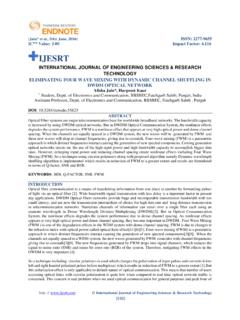Transcription of Dense Wavelength Division Multiplexing (DWDM)
1 Dense Wavelength Division Multiplexing ( dwdm ) Definition Dense Wavelength Division Multiplexing ( dwdm ) is a fiber-optic transmission technique that employs light wavelengths to transmit data parallel-by-bit or serial-by-character. Overview This tutorial addresses the importance of scalable dwdm systems in enabling service providers to accommodate consumer demand for ever- increasing amounts of bandwidth. dwdm is discussed as a crucial component of optical networks that allows the transmission of e- mail, video, multimedia, data, and voi ..carried in Internet protocol (IP), asynchronous transfer mode (ATM), and synchronous optical network/synchronous digital hierarchy (SONET/SDH), respectively, over the optical layer.
2 Topics 1. The Challenges of Today's Telecommunications Network 2. Resolving the Capacity Crisis 3. Capacity Expansion and Flexibility: dwdm 4. Capacity Expansion Potential 5. dwdm Incremental Growth 6. The Optical Layer as the Unifying Layer 7. Key dwdm System Characteristics 8. Conclusion Self- Test Correct Answers Glossary Web ProForum Tutorials Copyright The International Engineering Consortium 2/15 1. The Challenges of Today's Telecommunications Network To understand the importance of dwdm and optical networking, these capabilities must be discussed in the context of the challenges faced by the telecommunications industry, and, in particular, service providers.
3 Most networks were built using estimates that calculated bandwidth use by employing concentration ratios derived from classical engineering formulas such as Poisson and Reeling. Consequently, forecasts of the amount of bandwidth capacity needed for networks were calculated on the presumption that a given individual would only use network bandwidth six minutes of each hour. These formulas did not factor in the amount of traffic generated by Internet access (300 percent growth per year), faxes, multiple phone lines, modems, teleconferencing, and data and video transmission. Had these factors been included, a far different estimate would have emerged.
4 In fact, today many people use the bandwidth equivalent of 180 minutes or more each hour. Therefore, an enormous amount of bandwidth capacity is required to provide the services demanded by consumers. For perspective, in 1997, a long-distance carrier made major strides when it increased its bandwidth capacity to Gbps (billions of bits per second) over one fiber pair. At the transmission speed of one Gbps, one thousand books can be transmitted per second. However today, if one million families decide they want to see video on Web sites and sample the new emerging video applications, then network transmission rates of terabits (trillions of bits per second [Tbps]) are required.
5 With a transmission rate of one Tbps, it is possible to transmit 20 million simultaneous 2-way phone calls or transmit the text from 300 years worth of daily newspapers per second. No one could have predicted the network growth necessary to meet the demand. For example, one study estimated that from 1994 to 1998 the demand on the interexchange carriers' (IXCs ) network would increase sevenfold, and for the local exchange carriers' (LECs ) network, the demand would increase fourfold. In actuality, one company indicated that its network growth was 32 times that of the previous year, while another company's rate of growth in 1997 alone was the same size as its entire network in 1991.
6 Yet another has said that the size of its network doubled every six months in that four-year period. In addition to this explosion in consumer demand for bandwidth, many service providers are coping with fiber exhaust in their networks. An industry survey indicated that in 1995, the amount of embedded fiber already in use in the average network was between 70 percent and 80 percent. Today, many carriers are nearing one hundred percent capacity utilization across significant portions of their networks. Another problem for carriers is the challenge of deploying and integrating diverse technologies in one physical infrastructure. Customer demands and competitive pressures mandate that carriers offer diverse services Web ProForum Tutorials Copyright The International Engineering Consortium 3/15 economically and deploy them over the embedded network.
7 dwdm provides service providers an answer to that demand (see Figure 1). Figure 1. Optical Transport to Optical Networking: Evolution of the Phototonics Layer Use of dwdm allows providers to offer services such as e-mail, video, and multimedia carried as Internet protocol (IP) data over asynchronous transfer mode (ATM) and voice carried over SONET/SDH. Despite the fact that these formats IP, ATM, and SONET/SDH provide unique bandwidth management capabilities, all three can be transported over the optical layer using dwdm . This unifying capability allows the service provider the flexibility to respond to customer demands over one network.
8 A platform that is able to unify and interface with these technologies and position the carrier with the ability to integrate current and next-generation technologies is critical for a carrier's success. 2. Resolving the Capacity Crisis Faced with the multifaceted challenges of increased service needs, fiber exhaust, and layered bandwidth management, service providers need options to provide an economical solution. One way to alleviate fiber exhaust is to lay more fiber, and, for those networks where the cost of laying new fiber is minimal, this will prove the most economical solution. However, laying new fiber will not necessarily enable the service provider to provide new services or utilize the bandwidth management capability of a unifying optical layer.
9 A second choice is to increase the bit rate using time Division Multiplexing (TDM), where TDM increases the capacity of a fiber by slicing time into smaller intervals so that more bits (data) can be transmitted per second (see Figure 2). Traditionally, this has been the industry method of choice (DS 1, DS 2, DS 3, etc.). However, when service providers use this approach exclusively, they must Web ProForum Tutorials Copyright The International Engineering Consortium 4/15 make the leap to the higher bit rate in one jump, having purchased more capacity than they initially need. Based on the SONET hierarchy, the next incremental step from 10 Gbps TDM is 40 Gbps a quantum leap that many believe will not be possible for TDM technology in the near future.
10 This method has also been used with transport networks that are based on either the synchronous optical network (SONET) standard for North America or the synchronous digital network (SDH) standard for international networks. Figure 2. Increased Network Capacity TDM The telecommunications industry adopted the SONET or SDH standard to provide a standard synchronous optical hierarchy with sufficient flexibility to accommodate current and future digital signals. SONET or SDH accomplishes this by defining standard rates and formats and optical interfaces. For example, multiple electrical and optical signals are brought into a SONET terminal where they are terminated and multiplexed electrically before becoming part of the payload of an STS 1, the building block frame structure of the SONET hierarchy.














